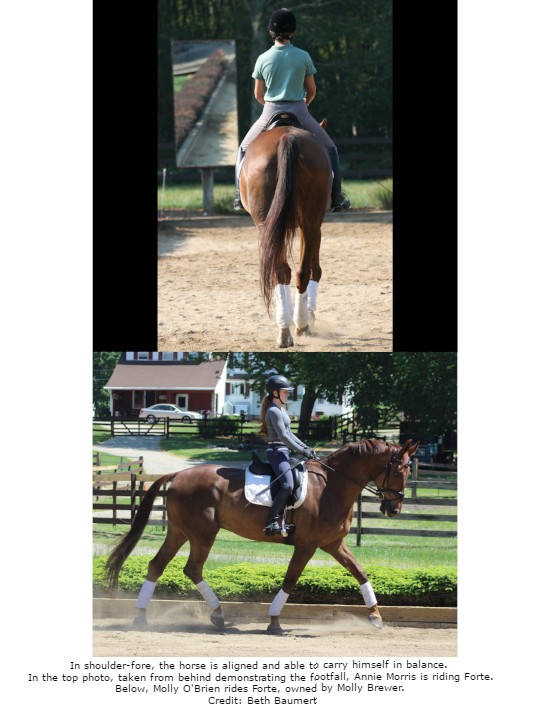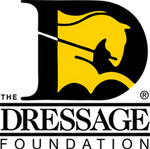Beth Baumert: "The Joy of a Balanced Horse"

Beth Baumert operates Cloverlea Dressage LLC in Columbia, CT where she trains horses and riders from Training Level through Grand Prix. She is a USDF Certified Instructor through Fourth Level and is an "L" graduate with distinction of the USDF judging program. Beth has been the technical editor for Dressage Today magazine for over 15 years. She is the author of When Two Spines Align: Dressage Dynamics. If this article helps you, you can find more information on the book at www.dressage-dynamics.com.
Everyone has had the experience of a difficult ride, and many—or maybe most—have experienced riding when it was easy, and everything feels perfect. In those blissful moments, it’s tempting to think, “Why can’t I do this all the time?”
Indeed, we need to have some control over aligning those stars that make for a beautiful ride. What makes the ride easy for both horse and rider? Balance. When your horse is balanced, he can be relaxed and rhythmic. There’s a great dance going on. If he’s out of balance, there is inevitable physical tension and usually mental tension too.
We’ve all felt the lack of balance: Horses can fall left, fall right and fall on the forehand. Horses are naturally unbalanced for these reasons:
1. The horse’s head and neck protrude from an otherwise table-like structure. Of course, there is more weight on the forehand.
2. Horses naturally respond to the rider’s leg aids by activating the forehand. Unless the rider teaches the horse otherwise, he will respond with his front legs and maybe even with his head and neck lurching skyward. As soon as those front legs cover more ground than the hind legs, the horse becomes a bit long and hollow in the frame and unpleasant in the hand.
3. The horse is naturally wider in his hips than he is in the shoulders, so he’s built on the forehand sort of like a wheelbarrow. To add insult to injury, the hind leg that is misaligned and stepping wide, thrusts the horse onto the opposite shoulder, which makes him even more misaligned and crooked.
Horses are not able to balance on their own. There was never a balanced horse under saddle that got that way without the help of the rider, and the answer to HOW to balance your horse is simple. I didn’t say it was easy, but it’s simple.
Here’s how:
Half Halts for Back-to-Front and Front-to-Back Balance
Half halts are intended to help the horse into a balanced frame by encouraging the hindquarters to initiate action and encouraging the forehand to wait.
Here’s how you prepare to do effective half halts: Be sure you can FOLLOW your horse and be “one” with him. First in the walk, and then in the trot and canter.
• Your hands should follow your horse’s mouth. The elbows open and close slightly so you can follow precisely. This isn’t easy. With soft hands, keep a light contact. Don’t drop the rein and don’t pull. Just follow the mouth. When you’re able to do that reliably, your horse will be very aware when you STOP following for a half halt.
• Your seat follows your horse’s back. Again, don’t let it move more than the horse, but don’t stiffen and do less than the horse. Follow very precisely. No pushing and shoving with your seat. When you can follow precisely and lightly, your horse will notice it when you stop following.
• Your legs follow the horse’s barrel. Quietly. Don’t fidget. Keep your legs long and ground yourself, but follow precisely. If you can follow and NOT use your leg, your horse will notice it when you DO use your leg.
Make an exercise of following. Practice it. When Courtney King Dye was first in training with Lendon Gray, she spent years practicing this. Courtney was never entirely satisfied with her ability to be one with her horse, which is why her horses were so attuned to her when she DID give an aid. She was an expert at NOT giving an aid, so her horses understood when she DID give an aid.
Now for the half halt:
The half halt should connect your horse from back to front and from front to back.
Try first in walk.
• Follow, follow, follow.
• Then stop following with the hands. Don’t pull, but just fix your hand. It’s often called a “non-giving hand.”
• And push with your seat and leg into that non-giving hand.
• Then soften the hand forward and follow again.
The effect should be that the horse closes his frame behind the saddle and connects to the bit in a better balance. Try it again and again. Try it in trot and in canter, tracking left and right. With practice, your timing will improve and your horse’s understanding will improve. Your horse will be better balanced from back to front.
Problems?
Is your horse blowing through your half halts? Then do a transition. If the half halt isn’t working in walk, go quietly to halt. Walk-halt-walk. Trot-walk-trot. Canter-trot canter. Transitions do the same job as half halts. They encourage the hindquarters to initiate action and they encourage the forehand to wait.
Is your horse losing his impulsion and/or losing the rhythm of the gait when you half halt? Be sure you’re using enough leg and that your arms and fingers are soft so his energy can “flow.” Be sure your upper body isn’t sitting against the horse’s direction of travel. Your body energy should always be going in the same direction as that of your horse.

Shoulder-fore for Left-to-Right and Right-to-Left Balance
Remember that horses are naturally balanced on the forehand and crooked because their hips are wider than their shoulders. Seen from behind, the haunches are inclined to travel toward the inside.
Shoulder-fore is the exercise that corrects this problem. Actually, it’s best not to think of shoulder-fore as an exercise or a movement, but rather the method used to straighten and balance your horse. Top riders are in shoulder-fore 100 percent of the time!
If you’re fortunate enough to have a mirror, ride straight into it. If not, get a friend to take a quick video and then watch it right away so you can try again.
For shoulder-fore right in walk:
• Flex your horse slightly to the right.
• Ride from your right leg to a soft, receiving left rein.
• With your right leg, try to narrow your horse’s right leg so it steps between your horse’s front feet. That will feel balanced because he will be stepping directly under your seat.
• With your outside leg, prevent your horse’s left hind from stepping out. The left hind should step in the same track as the left fore.
Do shoulder-fore left in walk. Then try it in trot and canter left and right.
Problems?
The biggest mistake is giving up. Shoulder-fore is not easy, but work it out. Without proper shoulder-fore, shoulder-in is impossible. Collection is impossible because the horse needs to be straight before he can collect.
There is nothing sideways about shoulder-fore. Remember that it’s a straightening exercise with only the suggestion of bend.
Put Two and Two Together
Be greedy. You want both lateral and longitudinal balance. Notice that in shoulder-fore, your aids shape your horse. Now half halt in the shape of shoulder-fore right. Organize yourself and half halt in the shape of shoulder-fore left. Half halt in the shape of 15-meter bend. Combine your ability to half halt with your ability to shape your horse.
Everyone has problems so don’t give up. Do you feel that your half halts aren’t working? Does your horse feel drunk when you try to do shoulder-fore? Trust me when I say that you are not alone. No one thinks half halts are easy, and no one rides shoulder-fore without concentrating on it.
Think about it and work on it quietly and patiently until your horse understands what you want and you get the desired result. Then you can say it’s simple AND easy. Your horse, because he loves being balanced, will meet you half way when he understands. He’ll be easy to ride in balance both longitudinally and laterally.
Kyra Kyrklund once said, “The only difference between the riders at the top and all the rest of the riders in the world is that the top riders are persistent about the many details of the basics.” Follow Kyra’s advice and you’ll be rewarded. Be persistent about balancing your horse.
